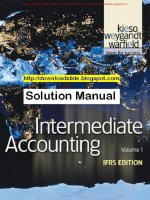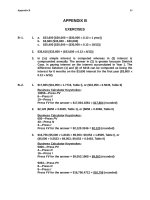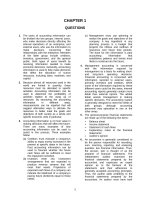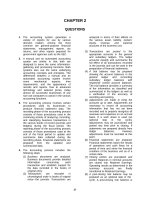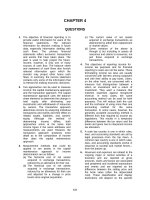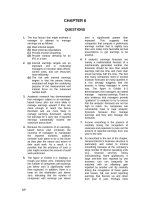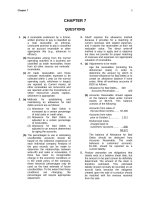Solution manual intermediate accounting 7th by nelson spiceland ch13
Bạn đang xem bản rút gọn của tài liệu. Xem và tải ngay bản đầy đủ của tài liệu tại đây (419.35 KB, 88 trang )
Find more slides, ebooks, solution manual and testbank on www.downloadslide.com
Chapter 13
Current Liabilities and Contingencies
AACSB assurance of learning standards in accounting and business education require
documentation of outcomes assessment. Although schools, departments, and faculty may approach
assessment and its documentation differently, one approach is to provide specific questions on
exams that become the basis for assessment. To aid faculty in this endeavor, we have labeled each
question, exercise, and problem in Intermediate Accounting, 7e, with the following AACSB learning
skills:
Questions
AACSB Tag
Brief Exercises
AACSB Tag
13–1
13–2
13–3
13–4
13–5
13–6
13–7
13–8
13–9
13–10
13–11
13–12
13–13
13–14
13–15
13–16
13–17
13–18
13–19
13–20
13–21
13–22
13–23
13–24
13–25
13–26
13–27
13–28
Reflective thinking
Reflective thinking
Reflective thinking
Reflective thinking
Reflective thinking
Reflective thinking
Reflective thinking
Reflective thinking
Reflective thinking
Reflective thinking
Reflective thinking
Reflective thinking
Reflective thinking
Diversity, Reflective thinking
Reflective thinking
Reflective thinking
Reflective thinking
Diversity, Reflective thinking
Reflective thinking
Reflective thinking
Reflective thinking
Reflective thinking
Reflective thinking
Diversity, Reflective thinking
Diversity, Reflective thinking
Reflective thinking
Reflective thinking
Diversity, Reflective thinking
13–12
13–13
13–14
13–15
13–16
13–17
13–18
13–19
13–20
Analytic
Analytic
Analytic
Analytic
Analytic
Analytic
Analytic
Analytic
Analytic
Brief Exercises
13–1
13–2
13–3
13–4
13–5
13–6
13–7
13–8
13–9
13–10
13–11
Solutions Manual, Vol.2, Chapter 13
Analytic
Analytic
Analytic
Analytic
Analytic
Analytic
Analytic
Analytic
Analytic
Analytic
Analytic
Exercises
13–1
13–2
13–3
13–4
13–5
13–6
13–7
13–8
13–9
13–10
13–11
13–12
13–13
13–14
13–15
13–16
13–17
13–18
13–19
13–20
13–21
13–22
13–23
13–24
13–25
13–26
13–27
Analytic
Analytic
Analytic
Analytic
Analytic
Analytic
Analytic
Analytic
Analytic
Communications
Analytic
Analytic
Analytic
Communications
Analytic, Reflective thinking
Analytic
Analytic, Reflective thinking
Analytic, Communications
Analytic
Reflective thinking
Analytic
Analytic, Reflective thinking
Reflective thinking
Analytic
Analytic
Analytic
Analytic
CPA/CMA
1
2
Analytic
Analytic
© The McGraw-Hill Companies, Inc., 2013
13–1
Find more slides, ebooks, solution manual and testbank on www.downloadslide.com
CPA/CMA cont.
AACSB Tags
3
4
5
6
7
8
9
1
2
3
4
Analytic
Analytic
Analytic
Analytic
Diversity, Reflective thinking
Diversity, Reflective thinking
Diversity, Reflective thinking
Reflective thinking
Reflective thinking
Reflective thinking
Reflective thinking
Problems
13–1
13–2
13–3
13–4
13–5
13–6
13–7
13–8
13–9
13–10
13–11
13–12
13–13
Analytic
Analytic
Analytic
Analytic
Analytic
Analytic
Analytic, Reflective thinking
Analytic
Analytic
Analytic
Reflective thinking
Analytic, Communications
Analytic
© The McGraw-Hill Companies, Inc., 2013
13–2
Intermediate Accounting, 7e
Find more slides, ebooks, solution manual and testbank on www.downloadslide.com
QUESTIONS FOR REVIEW OF KEY TOPICS
Question 13–1
A liability involves the past, the present, and the future. It is a present responsibility, to
sacrifice assets in the future, caused by a transaction or other event that already has happened.
Specifically, “Elements of Financial Statements,” Statement of Financial Accounting Concepts No.
6, par. 36, describes three essential characteristics: Liabilities–
1. are probable, future sacrifices of economic benefits
2. that arise from present obligations (to transfer goods or provide services) to other entities
3. that result from past transactions or events.
Question 13–2
Liabilities traditionally are classified as either current liabilities or long-term liabilities in a
classified balance sheet. Current liabilities are those expected to be satisfied with current assets or
by the creation of other current liabilities. Usually, but with exceptions, current liabilities are
obligations payable within one year or within the firm's operating cycle, whichever is longer.
Question 13–3
In concept, liabilities should be reported at their present values; that is, the valuation amount is
the present value of all future cash payments resulting from the debt, usually principal and/or interest
payments. In this case, the amount would be determined as the present value of $100,000,
discounted for three months at an appropriate rate of interest for a debt of this type. This is proper
because of the time value of money.
In practice, liabilities ordinarily are reported at their maturity amounts if payable within one
year because the relatively short time period makes the interest or time value component immaterial.
[FASB ASC 835–30–15–3: “Interest–Imputation of Interest–Scope and Scope Exceptions
(previously “Interest on Receivables and Payables,” Accounting Principles Board Opinion No 21,
(New York, AICPA, August 1971, Par. 3))] specifically exempts from present value valuation all
liabilities arising in connection with suppliers in the normal course of business and due within a
year.
Solutions Manual, Vol.2, Chapter 13
© The McGraw-Hill Companies, Inc., 2013
13–3
Find more slides, ebooks, solution manual and testbank on www.downloadslide.com
Answers to Questions (continued)
Question 13–4
Lines of credit permit a company to borrow cash from a bank up to a prearranged limit at a
predetermined, usually floating, rate of interest. The interest rate often is based on current rates of
the prime London interbank borrowing, certificates of deposit, bankers’ acceptance, or other
standard rates. Lines of credit usually must be available to support the issuance of commercial
paper.
Lines of credit can be noncommitted or committed. A noncommitted line of credit allows the
company to borrow without having to follow formal loan procedures and paperwork at the time of
the loan and is less formal, usually without a commitment fee. Sometimes a compensating balance
is required to be on deposit with the bank as compensation for the service. A committed line of
credit is more formal. It usually requires a commitment fee in the neighborhood of 1/4 of one percent
of the unused balance during the availability period. Sometimes compensating balances also are
required.
Question 13–5
When interest is “discounted” from the face amount of a note at the time it is written, it usually
is referred to as a “noninterest-bearing” note. Noninterest-bearing notes do, of course entail interest,
but the interest is deducted (or discounted) from the face amount to determine the cash proceeds
made available to the borrower at the outset and included in the amount paid at maturity. In fact, the
effective interest rate is higher than the stated discount rate because the discount rate is applied to
the face value, but the cash borrowed is less than the face value.
Question 13–6
Commercial paper represents loans from other corporations. It refers to unsecured notes sold
in minimum denominations of $25,000 with maturities ranging from 30 to 270 days. The firm
would be required to file a registration statement with the SEC if the maturity is beyond 270 days.
The name “commercial paper” implies that a paper certificate is issued to the lender to represent the
obligation. But, increasingly, no paper is created because the entire transaction is computerized.
Recording the issuance and payment of commercial paper is the same as for notes payable.
The interest rate usually is lower than in a bank loan because commercial paper (a) typically is
issued by large, sound companies (b) directly to the lender, and (c) normally is backed by a line of
credit with a bank.
Question 13–7
This is an example of an accrued expense—an expense incurred during the current period, but
not yet paid. he expense and related liability should be recorded as follows:
Salaries expense
Salaries payable
5,000
5,000
This achieves a proper matching of this expense with the revenues it helps generate, and
recognizes that a liability has been created by the employee earning wages for which she has not yet
been paid.
© The McGraw-Hill Companies, Inc., 2013
13–4
Intermediate Accounting, 7e
Find more slides, ebooks, solution manual and testbank on www.downloadslide.com
Answers to Questions (continued)
Question 13–8
An employer should accrue an expense and the related liability for employees' compensation for
future absences, like vacation pay, if the obligation meets each of four conditions: (1) the obligation
is attributable to employees' services already performed, (2) the paid absence can be taken in a later
year—the benefit vests (will be compensated even if employment is terminated) or the benefit can be
accumulated over time, (3) the payment is probable, and (4) the amount can be reasonably
estimated.
Customary practice should be considered when deciding whether an obligation exists. For
instance, whether the rights to paid absences have been earned by services already rendered
sometimes depends on customary policy for the absence in question. An example is whether
compensation for upcoming sabbatical leave should be accrued. Is it granted only to perform
research beneficial to the employer? Or, is it customary that sabbatical leave is intended to provide
unrestrained compensation for past service?
Similar concerns also influence whether unused rights to the paid absences can be carried
forward or expire. Although holiday time, military leave, maternity leave, and jury time typically do
not accumulate if unused, if it is customary practice that one can be carried forward, a liability is
accrued if it’s probable employees will be compensated in a future year. Similarly, sick pay is
specifically excluded from mandatory accrual, according to GAAP regarding compensated absences,
because future absence depends on future illness, which usually is not a certainty. But, if company
policy or custom is that employees are paid “sick pay” even when their absence is not due to illness,
a liability for unused sick pay should be recorded.
Question 13–9
When a company collects cash from a customer as a refundable deposit or as an advance
payment for products or services, a liability is created obligating the firm to return the deposit or to
supply the products or services. When the amount is to be returned to the customer in cash, it is a
refundable deposit. When the amount will be applied to the purchase price when goods are
delivered or services provided (gift certificates, magazine subscriptions, layaway deposits, special
order deposits, and airline tickets), it is a customer advance.
Question 13–10
Gift cards are a particular form of advance collection of revenues. When the payment is
received, the seller debits cash and credits an unearned revenue liability. Later, unearned revenue is
reduced and revenue recognized either when the customer redeems the gift card or when the
probability of redemption is viewed as remote, based on an expiration date or the company’s
experience.
Question 13–11
Examples of amounts collected for third parties that represent liabilities until remitted are sales
taxes, and payroll-related deductions such as federal and state income taxes, social security taxes,
employee insurance, employee contributions to retirement plans, and union dues.
Solutions Manual, Vol.2, Chapter 13
© The McGraw-Hill Companies, Inc., 2013
13–5
Find more slides, ebooks, solution manual and testbank on www.downloadslide.com
Answers to Questions (continued)
Question 13–12
The requirement to classify currently maturing debt as a current liability includes debt that is
callable, or due on demand, by the creditor in the upcoming year, even if the debt is not expected to
be called.
Question 13–13
Short-term obligations can be reported as noncurrent liabilities if the company (a) intends to
refinance on a long-term basis and (b) demonstrates the ability to do so by a refinancing agreement
or by actual financing.
Question 13–14
Under U.S. GAAP, ability to finance must be demonstrated by securing financing prior to the
date the balance sheet is issued; under IFRS, ability to finance must be demonstrated by securing
financing prior to the balance sheet date (which typically is a couple of months earlier than the date
of issuance).
Question 13–15
A loss contingency is an existing situation or set of circumstances involving potential loss that
will be resolved when some future event occurs or doesn’t occur. Examples: (1) a possible repair to
a product under warranty, (2) a possible uncollectible receivable, (3) being the defendant in a
lawsuit.
Question 13–16
The likelihood that the future event(s) will confirm the incurrence of the liability must be
categorized as:
PROBABLE—the confirming event is likely to occur.
REASONABLY POSSIBLE—the chance the confirming event will occur is more than remote but
less than likely.
REMOTE—the chance the confirming event will occur is slight.
Question 13–17
A liability should be accrued if it is both probable that the confirming event will occur and the
amount can be at least reasonably estimated.
© The McGraw-Hill Companies, Inc., 2013
13–6
Intermediate Accounting, 7e
Find more slides, ebooks, solution manual and testbank on www.downloadslide.com
Answers to Questions (continued)
Question 13–18
Under U.S. GAAP, the term “contingent liability” is used to refer generally to contingent
losses, regardless of probability. Under IFRS, a contingent liability refers only to those
contingencies that are not recognized in the financial statements; the term “provision” is used to
refer to those that are accrued as liabilities because they are probable and reasonably estimable.
Question 13–19
If one or both of the accrual criteria is not met, but there is at least a reasonable possibility that
an obligation exists (the loss will occur), a disclosure note should describe the contingency. The
note also should provide an estimate of the possible loss or range of loss, if possible. If an estimate
cannot be made, a statement to that effect should be included.
Question 13–20
1. Manufacturers’ product warranties—these inevitably involve expenditures, and reasonably
accurate estimates of the total liability for a period usually are possible, based on prior
experience.
2. Cash rebates and other premium offers—these inevitably involve expenditures, and reasonably
accurate estimates of the total liability for a period usually are possible, based on prior
experience.
Question 13–21
The contingent liability for warranties and guarantees usually is accrued. The estimated
warranty (guarantee) liability is credited and warranty (guarantee) expense is debited in the reporting
period in which the product under warranty is sold. An extended warranty provides warranty
protection beyond the manufacturer’s original warranty. A manufacturer’s warranty is offered as an
integral part of the product package. By contrast, an extended warranty is priced and sold separately
from the warranted product. It essentially constitutes a separate sales transaction and is recorded as
such.
Question 13–22
Several weeks usually pass between the end of a company’s fiscal year and the date the
financial statements for that year actually are issued. Any enlightening events occurring during this
period should be used to assess the nature of a loss contingency existing at the report date. Since a
liability should be accrued if it is both probable that the confirming event will occur and the amount
can be at least reasonably estimated, the contingency should be accrued.
Solutions Manual, Vol.2, Chapter 13
© The McGraw-Hill Companies, Inc., 2013
13–7
Find more slides, ebooks, solution manual and testbank on www.downloadslide.com
Answers to Questions (concluded)
Question 13–23
When a contingency comes into existence only after the year-end, a liability cannot be accrued
because none existed at the end of the year. Yet, if the loss is probable and can be reasonably
estimated, the contingency should be described in a disclosure note. The note should include the
effect of the loss on key accounting numbers affected. Furthermore, even events other than
contingencies that occur after the year-end but before the financial statements are issued must be
disclosed in a “subsequent events” disclosure note if they have a material effect on the company’s
financial position (i.e., an issuance of debt or equity securities, a business combination, or
discontinued operations).
Question 13–24
In U.S. GAAP, the low end of the range is accrued as a liability, and the rest of the range is
disclosed. In IFRS, the mid-point of the range is accrued.
Question 13–25
In IFRS, present values must be used to measure a liability whenever the time value of money
is material. That requirement does not exist for U.S. GAAP.
Question 13–26
When an assessment is probable, reporting the possible obligation would be warranted if an
unfavorable settlement is at least reasonably possible. This means an estimated loss and contingent
liability would be accrued if (a) an unfavorable outcome is probable and (b) the amount can be
reasonably estimated. Otherwise, note disclosure would be appropriate. So, when the assessment is
unasserted as yet, a two-step process is involved in deciding how it should be reported:
1. Is the assessment probable? If it is not, no disclosure is warranted.
2. If the assessment is probable, evaluate (a) the likelihood of an unfavorable outcome and (b)
whether the dollar amount can be estimated to determine whether it should be accrued,
disclosed only, or neither.
Question 13–27
You should not accrue your gain. A gain contingency should not be accrued. This
conservative treatment is consistent with the general inclination of accounting practice to anticipate
losses, but to recognize gains only at their realization. Though gain contingencies are not recorded
in the accounts, they should be disclosed in notes to the financial statements. Attention should be
paid that the disclosure note not give "misleading implications as to the likelihood of realization."
Question 13–28
You should accrue your gain. Under IFRS, a gain contingency is accrued if it is virtually
certain to occur, as is the case with respect to this gain.
© The McGraw-Hill Companies, Inc., 2013
13–8
Intermediate Accounting, 7e
Find more slides, ebooks, solution manual and testbank on www.downloadslide.com
BRIEF EXERCISES
Brief Exercise 13–1
Cash ...............................................................
Notes payable ..............................................
60,000,000
Interest expense ($60,000,000 x 12% x 3/12) ........
Interest payable ..........................................
1,800,000
60,000,000
1,800,000
Brief Exercise 13–2
Cash (difference) ..........................................................
Discount on notes payable ($60,000,000 x 12% x 9/12) ...
Notes payable (face amount) ....................................
Interest expense ($60,000,000 x 12% x 3/12)...................
Discount on notes payable ....................................
54,600,000
5,400,000
60,000,000
1,800,000
1,800,000
Brief Exercise 13–3
a.
December 31
$100,000 x 12% x 6/12 = $6,000
b.
September 30
$100,000 x 12% x 3/12 = $3,000
Solutions Manual, Vol.2, Chapter 13
© The McGraw-Hill Companies, Inc., 2013
13–9
Find more slides, ebooks, solution manual and testbank on www.downloadslide.com
Brief Exercise 13–4
Cash (difference) ..........................................................
Discount on notes payable ($12,000,000 x 9% x 9/12) .....
Notes payable (face amount) ....................................
11,190,000
810,000
12,000,000
Interest expense ........................................................
Discount on notes payable ...........................................
810,000
Notes payable (face amount) ........................................
Cash .......................................................................
12,000,000
810,000
12,000,000
Brief Exercise 13–5
Cash (difference) ..........................................................
Discount on notes payable ($10,000,000 x 6% x 9/12) .....
Notes payable (face amount) ....................................
Effective interest rate:
Discount ($10,000,000 x 6% x 9/12)
Cash proceeds
Interest rate for 9 months
Annual effective rate
© The McGraw-Hill Companies, Inc., 2013
13–10
9,550,000
450,000
10,000,000
$ 450,000
÷ $9,550,000
4.712%
x 12/9
___________
6.3%
Intermediate Accounting, 7e
Find more slides, ebooks, solution manual and testbank on www.downloadslide.com
Brief Exercise 13–6
December 12
Cash .......................................................................
Liability—customer advance ............................
24,000
January 16
Cash .......................................................................
Liability—customer advance ................................
Sales revenue .....................................................
216,000
24,000
24,000
240,000
Brief Exercise 13–7
In 2013 Lizzie would recognize $11,500 of revenue ($4,000 + 3,000 + 2,500 +
2,000). In 2014 Lizzie would recognize the remainder of $6,500 ($18,000 –
11,500), either because gift cards were redeemed (the $1,000 in January and the
$500 in February) or because they are viewed as expired.
Brief Exercise 13–8
Accounts receivable ..............................................
Sales revenue ....................................................
Sales taxes payable ([6% + 1.5%] x $600,000).......
645,000
600,000
45,000
Brief Exercise 13–9
1. Current liability—The requirement to classify currently maturing debt as a current liability
includes debt that is callable, or due on demand, by the creditor in the upcoming year even if
the debt is not expected to be called.
2 Long-term liability—The current liability classification includes (a) situations in which the
creditor has the right to demand payment because an existing violation of a provision of the debt
agreement makes it callable and (b) situations in which debt is not yet callable, but will be
callable within the year if an existing violation is not corrected within a specified grace
period—unless it's probable the violation will be corrected within the grace period. In this case,
the existing violation is expected to be corrected within six months.
Solutions Manual, Vol.2, Chapter 13
© The McGraw-Hill Companies, Inc., 2013
13–11
Find more slides, ebooks, solution manual and testbank on www.downloadslide.com
Brief Exercise 13–10
Under U.S. GAAP, the debt would be classified as long-term for both completion
dates, as what is key is that the refinancing be completed before the financial
statements are issued.
Brief Exercise 13–11
Under IFRS, the debt would be classified as long-term if the refinancing was
completed by December 15, 2013, but not if completed by January 15, 2014,
because for IFRS what is key is that the refinancing be completed by the balance
sheet date.
Brief Exercise 13–12
This is a loss contingency and the estimated warranty liability is credited and
warranty expense is debited in the period in which the products under warranty
are sold. Right will report a liability of $130,000:
Warranty Liability
_________________________________________
150,000
Warranty expense (1% x $15,000,000)
130,000
Balance
Actual expenditures 20,000
Brief Exercise 13–13
This is a loss contingency and should be accrued because it is both probable that
the confirming event will occur and the amount can be at least reasonably
estimated. Goo Goo should report a $5.5 million loss in its income statement and
a $5.5 million liability in its balance sheet
Loss—product recall ....................................................... 5,500,000
Liability—product recall..........................................
5,500,000
A disclosure note also is appropriate.
© The McGraw-Hill Companies, Inc., 2013
13–12
Intermediate Accounting, 7e
Find more slides, ebooks, solution manual and testbank on www.downloadslide.com
Brief Exercise 13–14
This is a gain contingency. Gain contingencies are not accrued even if the gain is
probable and reasonably estimable. The gain should be recognized only when
realized. A carefully worded disclosure note is appropriate.
Brief Exercise 13–15
This is a loss contingency. A liability should be accrued if it is both probable that
the confirming event will occur and the amount can be at least reasonably
estimated. If one or both of these criteria is not met (as in this case), but there is at
least a reasonable possibility that the loss will occur, a disclosure note should
describe the contingency. That’s what Bell should do here.
Brief Exercise 13–16
Only the third situation’s costs should be accrued. A liability should be accrued
for a loss contingency if it is both probable that the confirming event will occur
and the amount can be at least reasonably estimated. If one or both of these
criteria is not met, but there is at least a reasonable possibility that the loss will
occur, a disclosure note should describe the contingency. Both criteria are met
only for the warranty costs.
Brief Exercise 13–17
Under U.S. GAAP, no liability would be recognized, because a 51% chance is less
than the level of probability typically associated with “probable” in the United
States. A liability would be accrued under IFRS, as 51% is clearly “more likely
than not.” If a liability were accrued under U.S. GAAP, it would be for $10
million, the low end of the range, but under IFRS it would be for $15 million, the
midpoint of the range.
Brief Exercise 13–18
No disclosure is required because an EPA claim is not yet asserted, and an
assessment is not probable. Even if an unfavorable outcome is thought to be
probable in the event of an assessment and the amount is estimable, disclosure is
not required unless an unasserted claim is probable.
Solutions Manual, Vol.2, Chapter 13
© The McGraw-Hill Companies, Inc., 2013
13–13
Find more slides, ebooks, solution manual and testbank on www.downloadslide.com
EXERCISES
Exercise 13–1
Requirement 1
Cash ................................................................
Notes payable ..............................................
16,000,000
16,000,000
Requirement 2
Interest expense ($16,000,000 x 12% x 2/12) ........
Interest payable............................................
320,000
320,000
Requirement 3
Interest expense ($16,000,000 x 12% x 7/12) ........
Interest payable (from adjusting entry) ................
Notes payable (face amount) ..............................
Cash (total) ....................................................
1,120,000
320,000
16,000,000
17,440,000
Exercise 13–2
1.
2.
Interest rate
Fiscal year-end
12%
December 31
$400 million x 12% x 6/12 = $24 million
Interest rate
Fiscal year-end
10%
September 30
3
$400 million x 10% x /12 = $10 million
3.
4.
Interest rate
Fiscal year-end
9%
October 31
$400 million x 9% x 4/12 = $12 million
Interest rate
Fiscal year-end
6%
January 31
7
$400 million x 6% x /12 = $14 million
© The McGraw-Hill Companies, Inc., 2013
13–14
Intermediate Accounting, 7e
Find more slides, ebooks, solution manual and testbank on www.downloadslide.com
Exercise 13–3
2013
Jan. 13 No entry is made for a line of credit until a loan actually is made. It
would be described in a disclosure note.
Feb. 1
Cash ..........................................................................
Notes payable ........................................................
5,000,000
May 1
Interest expense ($5,000,000 x 10% x 3/12) ....................
Notes payable (face amount) ........................................
Cash ($5,000,000 + 125,000) ......................................
125,000
5,000,000
Dec. 1
Cash (difference) ..........................................................
Discount on notes payable ($10,000,000 x 9% x 9/12) .....
Notes payable (face amount) ....................................
5,000,000
5,125,000
9,325,000
675,000
10,000,000
Dec. 31
The effective interest rate is 9.6515% ($675,000 ÷ $9,325,000) x 12/9. So,
properly, interest should be recorded at that rate times the outstanding balance
times one-twelfth of a year:
Interest expense ($9,325,000 x 9.6515% x 1/12) ..............
Discount on notes payable ....................................
75,000
75,000
However the same results are achieved if interest is recorded at the discount
rate times the maturity amount times one-twelfth of a year:
Interest expense ($10,000,000 x 9% x 1/12) ....................
Discount on notes payable ....................................
Solutions Manual, Vol.2, Chapter 13
75,000
75,000
© The McGraw-Hill Companies, Inc., 2013
13–15
Find more slides, ebooks, solution manual and testbank on www.downloadslide.com
Exercise 13–3 (concluded)
2014
Sept. 1
Interest expense ($10,000,000 x 9% x 8/12)* ..................
Discount on notes payable ...................................
Notes payable (balance) ..............................................
Cash (maturity amount) .............................................
600,000
600,000
10,000,000
10,000,000
* or, ($9,325,000 x 9.6515% x 8/12) = $600,000
© The McGraw-Hill Companies, Inc., 2013
13–16
Intermediate Accounting, 7e
Find more slides, ebooks, solution manual and testbank on www.downloadslide.com
Exercise 13–4
Wages expense (increases wages expense to $410,000) ...........
Liability—compensated future absences ....................
* ($404,000 – 4,000] = $400,000
x 1/40 = $10,000
(4,000)
= $ 6,000
6,000
6,000*
non-vacation wages
vacation pay earned
vacation pay taken
vacation pay carried over
Exercise 13–5
Requirement 1
Wages expense (700 x $900) ..............................................
Liability—compensated future absences ............
630,000
630,000
Requirement 2
Liability—compensated future absences .................
Wages expense ($31 million + [5% x $630,000]) ..............
Cash (or wages payable) (total) .............................
Solutions Manual, Vol.2, Chapter 13
630,000
31,031,500
31,661,500
© The McGraw-Hill Companies, Inc., 2013
13–17
Find more slides, ebooks, solution manual and testbank on www.downloadslide.com
Exercise 13–6
Requirement 1
Cash ............................................................................
Liability—gift certificates ......................................
5,200
Cash ($2,100 + 84 – 1,300) .............................................
Liability—gift certificates .........................................
Sales revenue ..........................................................
Sales taxes payable (4% x $2,100).............................
884
1,300
Requirement 2
Gift certificates sold
Gift certificates redeemed
Liability to be reported at December 31
5,200
2,100
84
$5,200
(1,300)
$3,900
Requirement 3
The sales tax liability is a current liability because it is payable in January.
The liability for gift certificates is part current and part noncurrent:
Gift certificates sold
Estimated current liability
Gift certificates redeemed
Current liability at December 31
Noncurrent liability at December 31 ($5,200 x 20%)
Total
© The McGraw-Hill Companies, Inc., 2013
13–18
$5,200
x 80%
$4,160
(1,300)
$2,860
1,040
$3,900
Intermediate Accounting, 7e
Find more slides, ebooks, solution manual and testbank on www.downloadslide.com
Exercise 13–7
Requirement 1
Deposits Collected
Cash ..................................................................
Liability—refundable deposits ....................
850,000
Containers Returned
Liability—refundable deposits ........................
Cash ..............................................................
790,000
Deposits Forfeited
Liability—refundable deposits ........................
Revenue—sale of containers ........................
35,000
850,000
790,000
35,000
Cost of goods sold............................................
Inventory of containers ................................
Requirement 2
Balance on January 1
Deposits received
Deposits returned
Deposits forfeited
Balance on December 31
Solutions Manual, Vol.2, Chapter 13
35,000
35,000
$530,000
850,000
(790,000)
(35,000)
$555,000
© The McGraw-Hill Companies, Inc., 2013
13–19
Find more slides, ebooks, solution manual and testbank on www.downloadslide.com
Exercise 13–8
Requirement 1
Cash........................................................................
Liability—customer advance ............................
7,500
7,500
Requirement 2
Cash........................................................................
Liability—refundable deposits .........................
25,500
25,500
Requirement 3
Accounts receivable ...............................................
Sales revenue .....................................................
Sales taxes payable ([5% + 2%] x $800,000) ..........
© The McGraw-Hill Companies, Inc., 2013
13–20
856,000
800,000
56,000
Intermediate Accounting, 7e
Find more slides, ebooks, solution manual and testbank on www.downloadslide.com
Exercise 13–9
Requirement 1
The entire $10,000 sold in January will be recognized as revenue during
2011. $6,000 because of gift card redemption; $4,000 because of gift card
breakage.
Requirement 2
January Gift Card Sales
Cash ..................................................................
Liability—unearned gift card revenue .........
10,000
Redemption of January Gift Cards
Liability—unearned gift card revenue ............
Revenue—gift cards .....................................
6,000
Expiration of January Gift Cards
Liability—unearned gift card revenue ............
Revenue—gift cards .....................................
4,000
10,000
6,000
4,000
Requirement 3
Of the $16,000 sold in March, $10,000 will be recognized as revenue:
$4,000 because of gift card redemption; $6,000 of the remaining $12,000
because of gift card expiration. To calculate the amount of gift card
breakage, consider that, if March sales all occurred on the first day of the
month, all would have been outstanding for 10 months during 2013 and
therefore all $12,000 of nonredeemed gift cards would be viewed as
expired. On the other hand, if March sales all occurred on the last day of
the month, none would have been outstanding for 10 months during 2013
and therefore none of the $12,000 of nonredeemed gift cards would be
viewed as expired. Assuming that sales of gift cards occur on average on
March 15 gets us to the average of ($12,000 + 0) ÷ 2 = $6,000 from gift
card expiration.
Requirement 4
The only liability at 12/31/2013 would be the $6,000 of unexpired March
gift cards (see answer to requirement 3).
Solutions Manual, Vol.2, Chapter 13
© The McGraw-Hill Companies, Inc., 2013
13–21
Find more slides, ebooks, solution manual and testbank on www.downloadslide.com
Exercise 13–10
The FASB Accounting Standards Codification represents the single source of
authoritative U.S. generally accepted accounting principles. The specific citation for
each of the following items is:
1. If it is only reasonably possible that a contingent loss will occur, the
contingent loss should be disclosed:
FASB ACS 450–20–50–3: “Contingencies–Loss Contingencies–Disclosure–
Unrecognized Contingencies.”
2. Criteria allowing short-term liabilities expected to be refinanced to be
classified as long-term liabilities:
FASB ACS 470–10–45–14: “Debt–Overall–Other Presentation Matters–Intent
and Ability to Refinance on a Long-Term Basis.”
3. Accounting for separately priced extended warranty contracts:
FASB ACS 605–20–25–3: “Revenue Recognition–Services–Recognition–
Separately Priced Extended Warranty and Product Maintenance Contracts.”
4. The criteria to determine if an employer must accrue a liability for vacation
pay.
FASB ASC 710–10–25–1:“Compensation–General–Overall–Recognition.”
© The McGraw-Hill Companies, Inc., 2013
13–22
Intermediate Accounting, 7e
Find more slides, ebooks, solution manual and testbank on www.downloadslide.com
Exercise 13–11
Normally, short-term debt (payable within a year) is classified as current liabilities.
However, when such debt is to be refinanced on a long-term basis, it may be included
with long-term liabilities. The narrative indicates that Sprint has both (1) the intent
and (2) the ability ("existing long-term credit facilities") to refinance on a long-term
basis. Thus, Sprint reported the debt as long-term liabilities.
Exercise 13–12
Requirement 1
Normally, IFRS requires that short-term debt (payable within a year) be classified
as current liabilities. However, when such debt is to be refinanced on a long-term
basis, it may be included with long-term liabilities. The narrative indicates that Sprint
has both (1) the intent and (2) the ability ("existing long-term credit facilities") to
refinance on a long-term basis. Thus, Sprint reported the debt as long-term liabilities.
Requirement 2
IFRS requires that the refinancing capability be in place as of the balance sheet
date. Therefore, given that the refinancing was not arranged until after year-end, IFRS
would require that the debt be classified as a current liability.
Solutions Manual, Vol.2, Chapter 13
© The McGraw-Hill Companies, Inc., 2013
13–23
Find more slides, ebooks, solution manual and testbank on www.downloadslide.com
Exercise 13–13
1. Current liability: $10 million
The requirement to classify currently maturing debt as a current liability
includes debt that is callable by the creditor in the upcoming year—even if the
debt is not expected to be called.
2. Noncurrent liability: $14 million
The current liability classification includes (a) situations in which the creditor
has the right to demand payment because an existing violation of a provision of
the debt agreement makes it callable and (b) situations in which debt is not yet
callable, but will be callable within the year if an existing violation is not
corrected within a specified grace period—unless it's probable the violation
will be corrected within the grace period. In this case, the existing violation is
expected to be corrected within six months.
3. Current liability: $7 million
The debt should be reported as a current liability because it is payable in the
upcoming year, will not be refinanced with long-term obligations, and will not
be paid with a bond sinking fund.
© The McGraw-Hill Companies, Inc., 2013
13–24
Intermediate Accounting, 7e
Find more slides, ebooks, solution manual and testbank on www.downloadslide.com
Exercise 13–14
Requirement 1
The specific citation that specifies the guidelines for accruing loss contingencies is
FASB ACS 450–20–25–2: “Contingencies–Loss Contingencies–Recognition–General
Rule.”
Requirement 2
Specifically, the guidelines are that an estimated loss from a loss contingency be
accrued by a charge to income if both of the following conditions are met:
a. Information available prior to issuance of the financial statements indicates that
it is probable that an asset had been impaired or a liability had been incurred at
the date of the financial statements.
b. The amount of loss can be reasonably estimated.
Solutions Manual, Vol.2, Chapter 13
© The McGraw-Hill Companies, Inc., 2013
13–25
